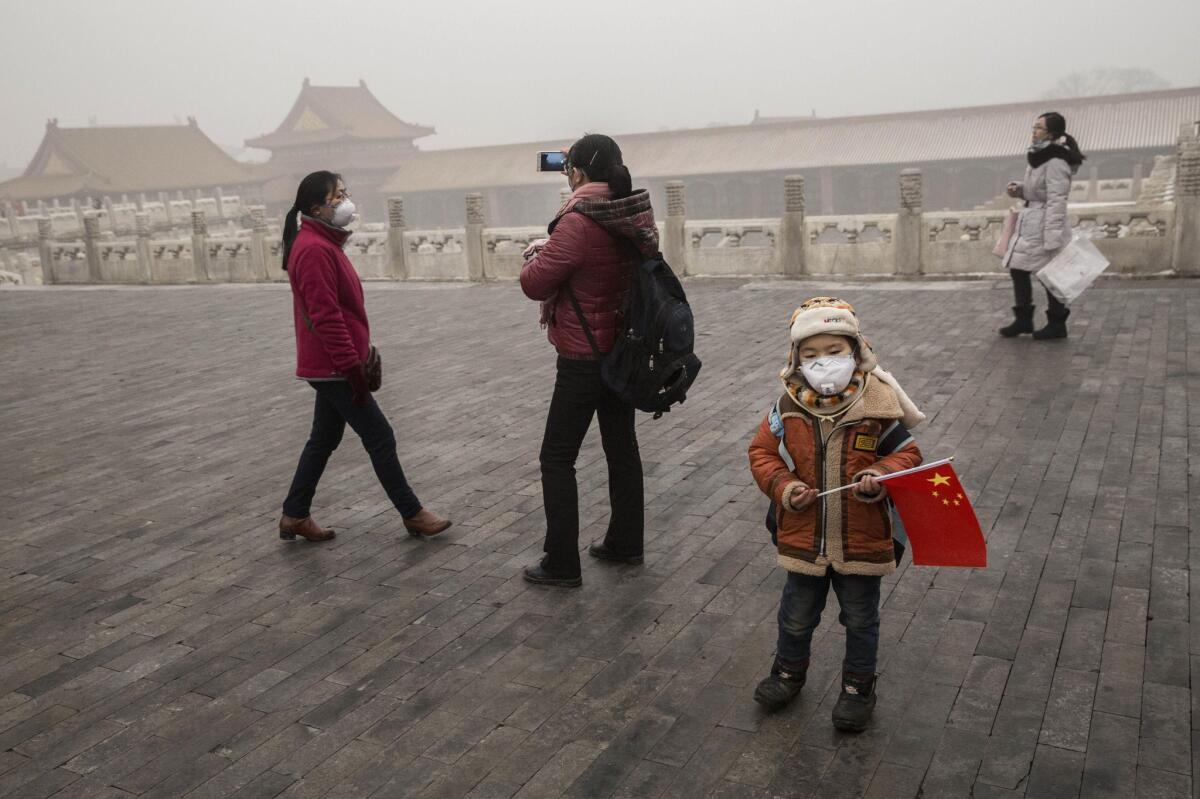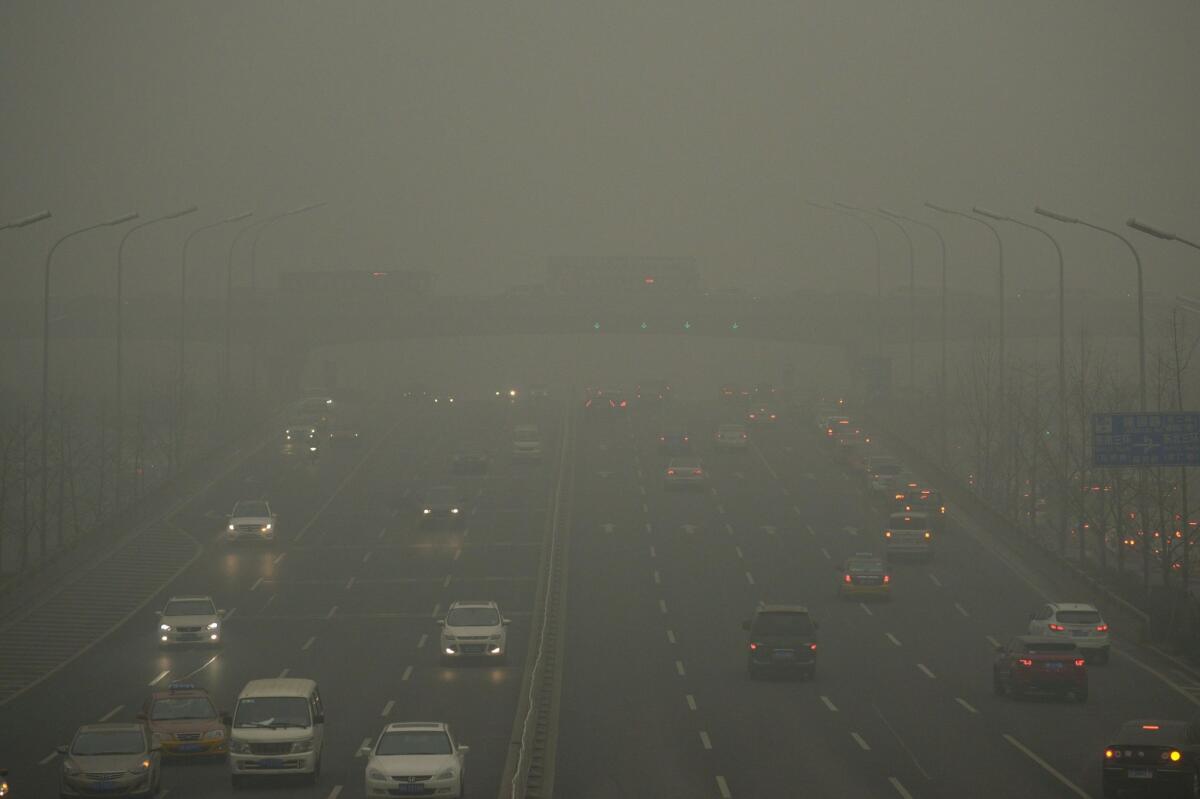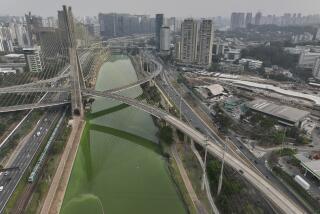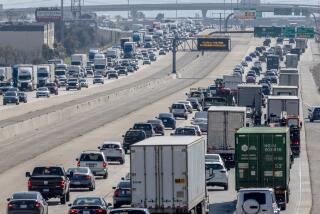Beijing’s smog: When a scale of zero to 500 doesn’t go high enough

A Chinese boy wears a mask as protection from the pollution as he stands with a China flag in Beijing’s Forbidden City during a high-pollution day on Tuesday.
reporting from beijing — In the space of an afternoon, Beijing vanished.
For days, the city was crisp and clear. Wind whipped down its ancient alleys and sprawling, 12-lane thoroughfares; an electric blue sky reflected in the glass walls of its postmodern office buildings. But by evening, all was gone, engulfed in a gauzy-white miasma. Buildings rose into hazy oblivion, and the sun became a dull yellow orb, like a flashlight shining from under a blanket.
That was Friday, when levels of PM2.5 — particularly noxious particulate matter, small enough to enter the bloodstream through the lungs — reached 429 micrograms per cubic meter, 17 times the World Health Organization’s recommended limit. By Monday, schools were closed; drivers were using their headlights at noon.

Cars disappear into smog in Beijing on Tuesday.
As China’s political and cultural capital, Beijing’s heady dynamism attracts a diverse population of ambitious, passionate people. There are quiet streets lined with persimmon trees, and leafy parks where the elderly practice tai chi. Travel opportunities are abundant; the art scene is terrific; residents are, on the whole, remarkably good-humored, hospitable and astute.
There are, of course, downsides. The Internet is censored, the food unsafe, and the political system a wellspring of injustice, from petty corruption to sweeping crackdowns on dissent. To live happily requires mental acrobatics, beginning with a focus on the bright spots: There are those blue-sky days. Livelihoods are improving. More people are traveling abroad.
And then, something happens that knocks everyone off balance. The pollution siege, which lasted through Tuesday, was one of those things. This has happened before, although this was one of the worst. Beijing residents have learned to take precautions. Some, if they can afford it, equip their homes and offices with expensive air purifiers. Some don 3M carpenters’ masks before going outside.
But on truly bad days, the smog cuts through everything, hitting the tongue with an acute, chemical twang. The city becomes unrecognizable. Colors lose their hue. Office buildings look derelict, their finer features failing to cut through the haze.
While there are pedestrians who wear face masks, most grin and bear it. Mothers bike their children to school with hollow eyes; drivers smoke cigarettes and tap their ashes through open windows. Speak with any of them and the conversation immediately turns to the smog — the tingle in the backs of everyone’s throats; the sadness, even embarrassment that they live in a city that is “unsuitable for human habitation,” as a state-backed think tank wrote in 2014.
Then, there’s the black humor — as soon as the smog descends, so do the memes. These last few days, Internet users sent around stills from zombie apocalypse movies; photoshopped images of alien monsters superimposed into smoggy urban landscapes; and a series of monochrome, gray photographs with Beijing’s major landmarks — the Temple of Heaven, the Rem Koolhaas-designed CCTV building — outlined in black marker.
NEWSLETTER: Get the day’s top headlines from Times Editor Davan Maharaj >>
On Sunday, President Xi Jinping traveled to the international climate change conference in Paris. In advance of his arrival, China’s environment minister, Chen Jining, announced that the country “has achieved the pollution-reduction targets for major pollutants outlined in its 12th Five-Year Plan, six months ahead of schedule,” according to the state-run China Daily.
Meanwhile, Beijing got worse. By Monday, the Air Quality Index, a widely recognized measure of air pollution, hit 587 on the usual scale of zero to 500, registering as “beyond index” on monitors throughout the city. (The United Nations’ recommended maximum level is 25.) The government issued an “orange weather alert,” temporarily suspending some factories and ordering schools to keep children indoors.
The problem’s scope is difficult to fathom. This week’s smog spread across a land mass of 204,634 square miles, according to the Ministry of Environmental Protection — about 25% larger than the state of California.
For years, the government blocked reporting on the smog, until a similar stretch of record-breaking pollution in 2013 — dubbed the Airpocalypse by Internet users — resulted in a surge of public complaints (and a run on air purifiers). In 2014, premier Li Keqiang said in a speech that the government would “declare war’’ on smog. Authorities began releasing air pollution data with unprecedented transparency. They shut down coal-fired plants in central Beijing. This April, Greenpeace released a detailed report noting that air pollution in Beijing and 359 other Chinese cities had “modestly improved in the last 12 months.”
“The air getting really bad helps with stronger implementation of the new regulations, but these regulations have a lengthy phase-in period,” said Deborah Seligsohn, an expert on China’s environment at UC San Diego.
“I went to a meeting in 2010 when environmental officials were talking about dealing with PM2.5,” she continued. “So it’s not that they didn’t know what they were doing, or that change happens only because of public opinion. The reality is that it’s not just the public living in this highly polluted environment, it’s also high government officials — so every time the air gets really bad, they have to explain what went wrong to their bosses. And when you’re in such a top-down system, that makes a difference.”
By Tuesday, the fifth straight day of smog, the color of the air had turned from gray to a sinister orange. The air felt vaguely thick, making it difficult to concentrate. Eyes burned. During a long stretch of gray, it’s easy to fear that the miasma may never lift, that China’s environmental problems are intractable and that the government will never follow through on its promises to clear the skies.
But then, Tuesday night, a trace of wind fluttered through the city. A scattering of lights shone from the upper floors of skyscrapers. By Wednesday morning, the haze was gone completely; the sky was once again electric blue. All day, it arched over a landscape of vivid color and depth — mercifully returned to form, at least until the weather turns and the city once again vanishes.
Follow @JRKaiman on Twitter for news from Asia.
MORE ON CHINA
As its money goes global, can China loosen up?.
China prepares to rank its citizens on ‘social credit’
China frees imprisoned journalist, 71, after she pleads guilty
More to Read
Sign up for Essential California
The most important California stories and recommendations in your inbox every morning.
You may occasionally receive promotional content from the Los Angeles Times.










